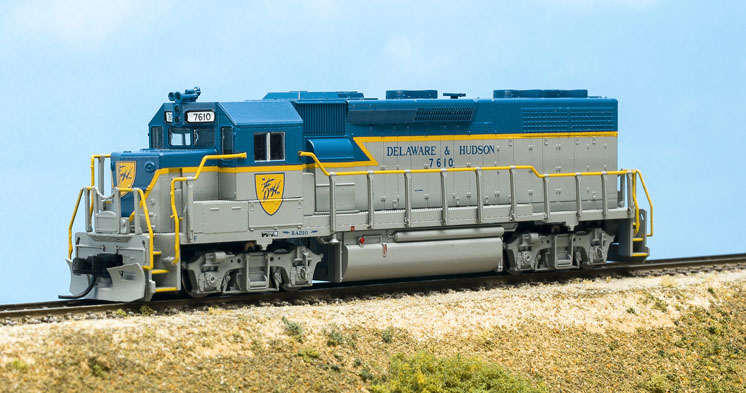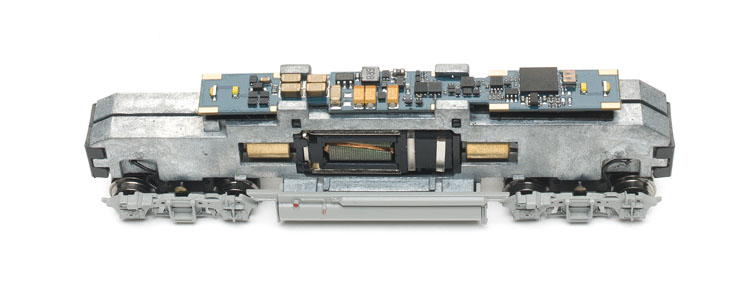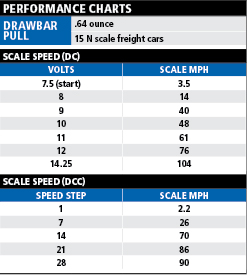Sound or no sound has been one of the basic questions when buying new locomotives. If you bought an engine without sound, but later wanted to add a Digital Command Control (DCC) sound decoder, one of the hurdles was finding a place for the speaker, especially in N scale.
Atlas Model Railroad Co. Inc. has another option for you: sound-ready locomotives with the speaker already installed. Our first such sample is a re-issue of Atlas’ N scale GP39-2. The model is also available with an Electronic Solutions Ulm (ESU) LokSound Select dual-mode sound decoder with Full Throttle sounds and effects package.
The prototype. Electro-Motive Division (EMD) didn’t expect to sell many GP39-2s after having sold only 23 predecessor GP39s. However, an improved turbocharger, better performance at high altitudes than the 2,000-hp GP38-2, and better economy made the 2,300-hp GP39-2 10 times more popular with customers than the GP39.
The Atchison, Topeka & Santa Fe Ry. owned the largest fleet of new GP39-2s, with 106 units purchased in five orders over six years. BNSF Ry. still has some GP39-2s on its roster, and others are still working on short lines.
Atlas’s model comes in two versions, Phase I and Phase II. Our sample was a Phase I model decorated for the Delaware & Hudson’s 1975 order. These locomotives have EMD’s Blomberg Type M trucks, identifiable by their rubber pads in place of leaf springs in the center of the truck, a single brake cylinder at one end of the truck, and a snubber, or shock absorber, on the other end.
The model has the correct 81″ nose of the Phase I locomotive, but the 3,600- gallon fuel tank is about 3 feet longer than that fitted on the D&H engines, which carried 2,900 gallons of fuel. Other dimensions were within scale inches of drawings published in the December 1988 issue of Mainline Modeler.
The classic D&H lightning stripe blue-and-gray paint scheme is well executed with sharp color separations and smooth, opaque paint. All the lettering is sharp and clear, with all but the smallest lettering on the General Motors builder’s plate legible under magnification.
The handrails are painted flexible plastic and appear to be close to scale size. Grab irons and uncoupling levers are molded in place. The walkways feature a textured tread pattern, and the window frames are trimmed in silver paint. The horn, snowplow, and dynamic brake compartment vent are separate pieces.
Under the hood is a traditional N scale split die-cast metal frame. This one is held together with plastic clips at the ends. Carefully wiggling the body shell allowed it to slip from the frame.
A sugar-cube-style speaker is mounted in the fuel tank area under the motor in both the direct-current (DC) and DCC models. Metal contact strips run from the speaker past the motor to connect to the bottom of the ESU LokSound Select decoder or lighting printed-circuit (PC) board mounted on top of the frame. Surface-mount light-emitting diodes (LEDs) illuminate the headlight, rear light, and number boxes.
The locomotive picks up current from all eight wheels. Fine wires pass the current from the trucks to the frame halves instead of metal wipers.
On the test track. To test the ESU LokSound-equipped GP39-2 on direct-current (DC), I used a Bachmann power pack. At 6.5V, the engine startup sequence commenced. At 7.5V, the locomotive started moving at 3.5 scale mph. At 12V, the engine reached 76 scale mph, matching the prototype’s top speed. Sounds were limited to the engine revving up and down with the locomotive’s speed. Headlights were directional.
On DCC, the locomotive was quiet until I pressed function button 8, which triggered the diesel engine startup sequence. The locomotive stated moving in speed step 1 at 2.2 scale mph and topped out at 90 scale mph in speed step 28 – a bit fast for a freight locomotive.
All the function buttons can be remapped, making it easy to customize the functions to better suit specific throttles or to create operating standards for your layout. The ESU LokProgrammer software is available as a free download (www.esu.eu/en/start/), which generates the proper configuration variable (CV) values so changes can then be made with a programming throttle. An extra-cost LokProgrammer interface connects a computer to a programming track, allowing changes to be uploaded directly to the decoder.
I took the engine to our Canadian Canyons project layout for real-world testing. I set some cars in place at the two industries on the layout. Using switching mode (function 7) on the LokSound decoder, it was easy to gradually power up and down to shift cars into and out of the sidings.
Even more fun was using the brake function on F10. This allowed me to set a reasonable speed on the locomotive, then start and stop using the independent brake. The engine note increased and decreased automatically as I started, stopped, reversed, and started again.
I tested the Full Throttle effects in the layout’s helix. Climbing the helix, I pressed F9, Drive/Hold, to keep the speed constant. I then used the speed control knob to throttle the engine to notch 8. On the way back down the helix, I dropped the throttle to notch 1, hearing the engine rpm lower. Then I pressed F4 to activate the dynamic brake, triggering a fan sound and cycling the diesel engine to the proper notch.
My test bench results said our locomotive should pull 15 N scale freight cars on straight and level track. To test things further, I started adding cars to my nine-car local until there were 12 cars tied on the back. This was the limit for the locomotive going up the 1.9 percent grade of the 181⁄2″ radius helix.
The GP39-2 wasn’t expected to be a big hit, but with more than 200 built over an 11-year period, and with a few still in operation today, these mid-sized locomotives could rightly earn themselves a place on any layout set in the 1970s to the present.
$139.95 (DC no sound)
Manufacturer
Atlas Model Railroad Co. Inc.
378 Florence Ave.
Hillside, NJ 07205
www.atlasrr.com
Era: mid-1970s to mid-1980s (as detailed and decorated for D&H)
Road names: Delaware & Hudson; Atchison, Topeka & Santa Fe (blue/yellow warbonnet and “Kodachrome”); CSX (YN2); Guilford (D&H); and Reading Co. (two road numbers each, plus undecorated)
Features
• Accumate magnetic knuckle couplers, at correct height
• Blackened metal wheels, in gauge
• Factory-installed speaker for conversion to DCC sound (DC version)
• ESU LokSound dual-mode decoder (DCC version)
• Weight: 2.7 ounces

















you never say what decoder drops in to this locomotive if one buys the DCC-ready version. for that reason your review is a waste of time